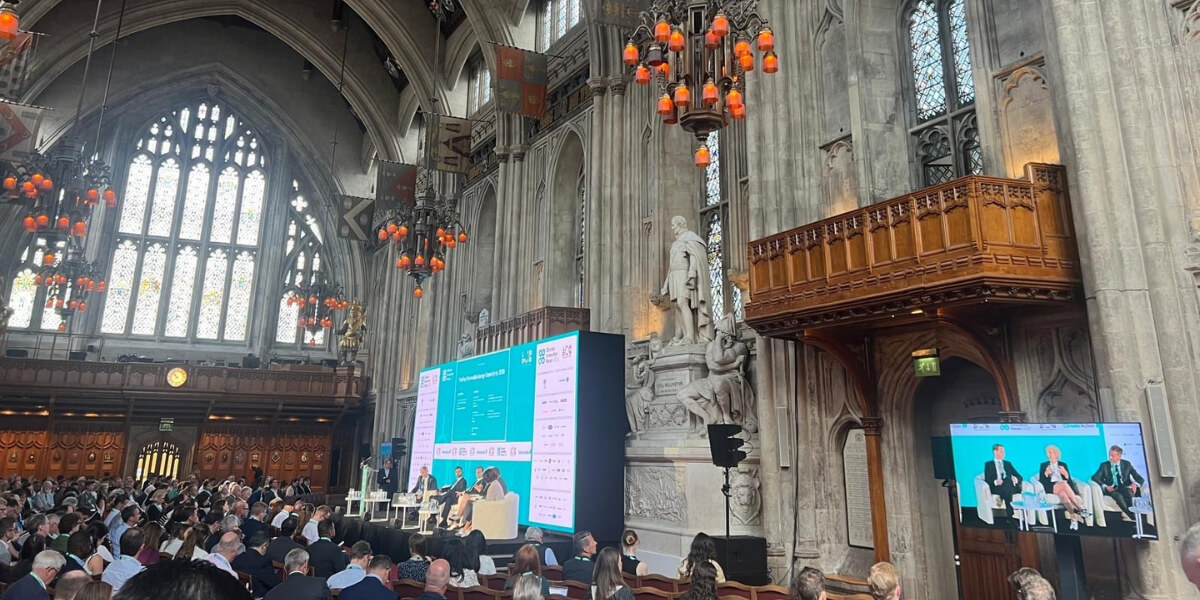Written by Sarah Gorman, Founding Team and Growth & Strategy Head, DAS
When 2,000+ leaders from business, finance, government, and civil society gather at London’s historic Guildhall for the 2025 Climate Innovation Forum – a.k.a. the “Super Bowl” of London Climate Week – the conversation quickly moves past ambition to action. This year, the focus wasn’t just on the $1.3 trillion needed annually for climate finance, but on the practical pathways to get there; closing the implementation gap, scaling innovation, and turning climate ambition into investable, real-world solutions.
Insurability: The New Climate Catalyst
“If it’s not insurable, it’s not investable.” Zurich Insurance Group’s Linda Freinder captured a shift that’s redefining climate action. Insurance – which has long been operating quietly in the background – is now at the centre of the climate and finance debate. Climate risk has been front of mind for insurers for decades, with MunichRe ringing the alarm bell since the 1970s. But as Howden observed, the tipping point came when influential people couldn’t get insurance. Suddenly, climate risk got very real, and the conversation became mainstream.
Without Insurance, Credit Dries Up
This resonated deeply. One of the biggest truths we work with at DAS is this: without insurance, credit stalls, mortgages vanish, and investment halts. Why? Because it’s the bedrock of the financial system. Insurance is a form of contingent finance — it underpins the ability to borrow, invest, and grow. In Australia, you can’t secure a mortgage unless the property is insurable. And what we do know is that as climate risk intensifies, the connection between finance, credit, and insurability will only tighten.
Integrating physical climate risk into financial decision-making will be one of the biggest shifts in the coming decade, as insurability rises up boardroom agendas and grows as a strategic driver of transformation.
Agriculture: The Canary In The Coal Mine
Rowan Douglas, Head of Climate Risk and Resilience at Howden, put it plainly: insurance must be made open and available. If we don’t, we risk a steady decline in farmers and farming altogether.
The average age of farmers is rising across the globe. In the EU, it’s 62. In Australia, that figure is 63. Without equitable risk-sharing, farming becomes too risky to sustain. Insurance isn’t just about payouts — it’s about enabling the next generation to do the job they love.
Crop Risk Will Become Everyone’s Problem
The numbers are sobering. Across the EU, crop yields are already falling by an average of 6% annually due to climate impacts. In some countries, it’s even higher. The economic consequences go far beyond the farm gate – if this trend persists, some nations face losing up to 10% of their GDP by 2030, with implications ranging from fluctuating food prices to export competitiveness to national food security. The bottom line? Crop risk matters to everyone – impacting food prices, export competitiveness, and national food security.
New tools, including DAS’s AI predictive crop forecasting suite, act like “magic glasses” for agriculture, giving lenders, governments, and industry unprecedented insight into risk.
The Tech Exists, Now We Must Connect It
One line from the forum really stuck with me: “There won’t just be droughts – there will be credit droughts.” The urgency isn’t just about producing food, but about ensuring the financial systems that support production stay strong.
When we started DAS, not everyone “got” the link between finance, insurance, and agriculture. Today, it’s obvious. Change starts off the farm, in the systems that ensure finance flows to those who need it most.
We at DAS see reason for optimism. Despite rising climate risks, agricultural lending in Australia hit a record $130B+. With the right tech – the kind that can predict, insure, and manage climate risk – we can keep that finance flowing.
And the forum consensus? We already have 65–80% of the technology we need to meet 2050 goals. What’s missing is integration. We need to break down silos across finance, insurance, and agriculture so that farmers, lenders, and insurers are working from the same playbook. That’s how we’ll get better results and ensure a thriving agricultural sector.
For us at DAS, that shift is off-farm: finance, risk, and the future of climate action.

Picture: (Left) Advisor and Ally of DAS, Inez Bartram Vilar and (Right) Sarah Gorman, Founding Team & Strategy and Marketing Head at DAS - attending the Climate Innovation Forum.
Is monitoring rural climate risk possible down to property-level?
Yes, it is. DAS is leading the way by providing state-of-the-art rural climate datasets that enable highly specific and local insights on how both acute and chronic climate stressors are impacting properties, their production and their value.
To find our more, fill out the form below to download our report "Mapping Climate Risk: A Data-Driven Guide to Rural Property Risk, Resilience, and Opportunity".



